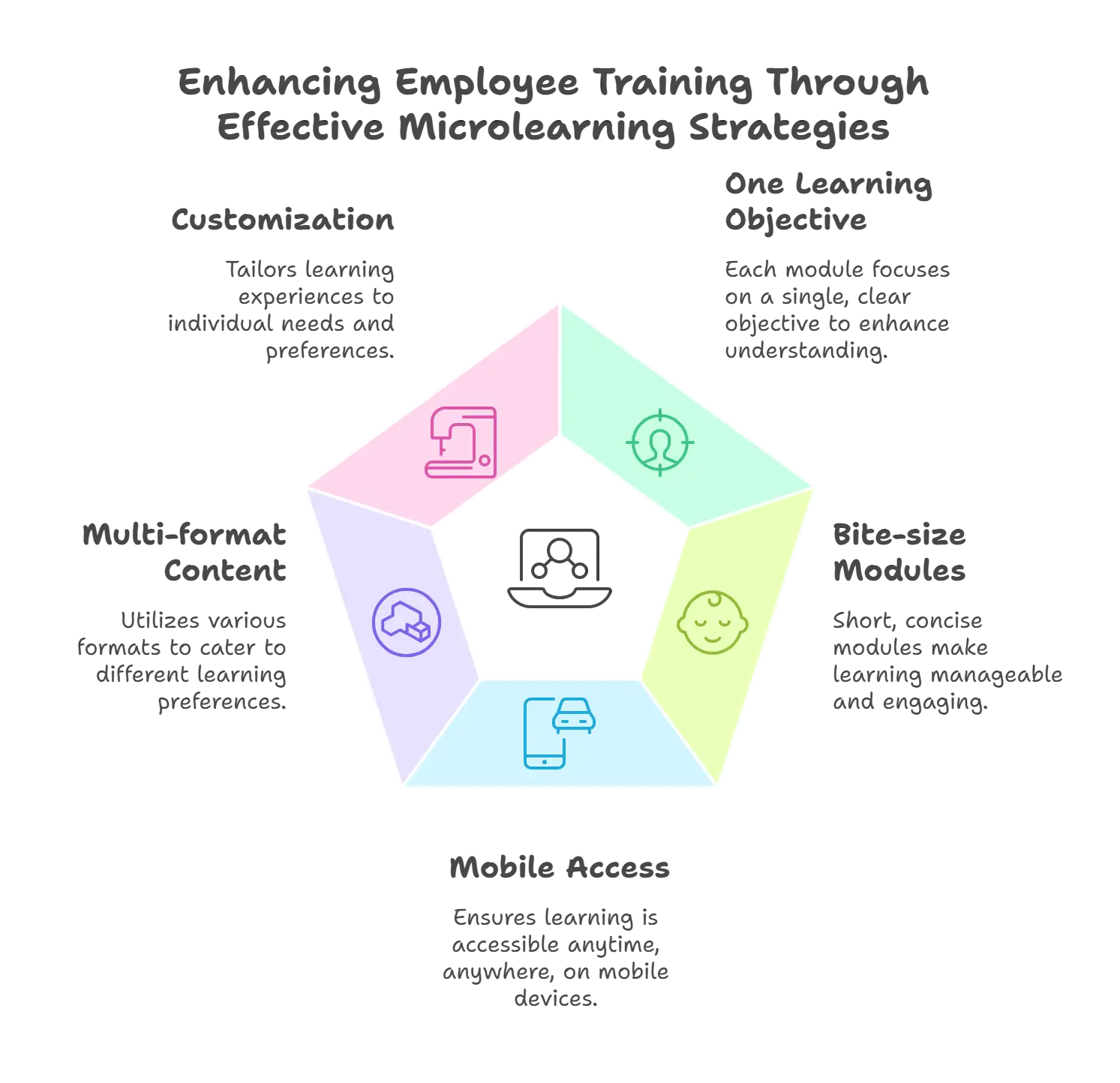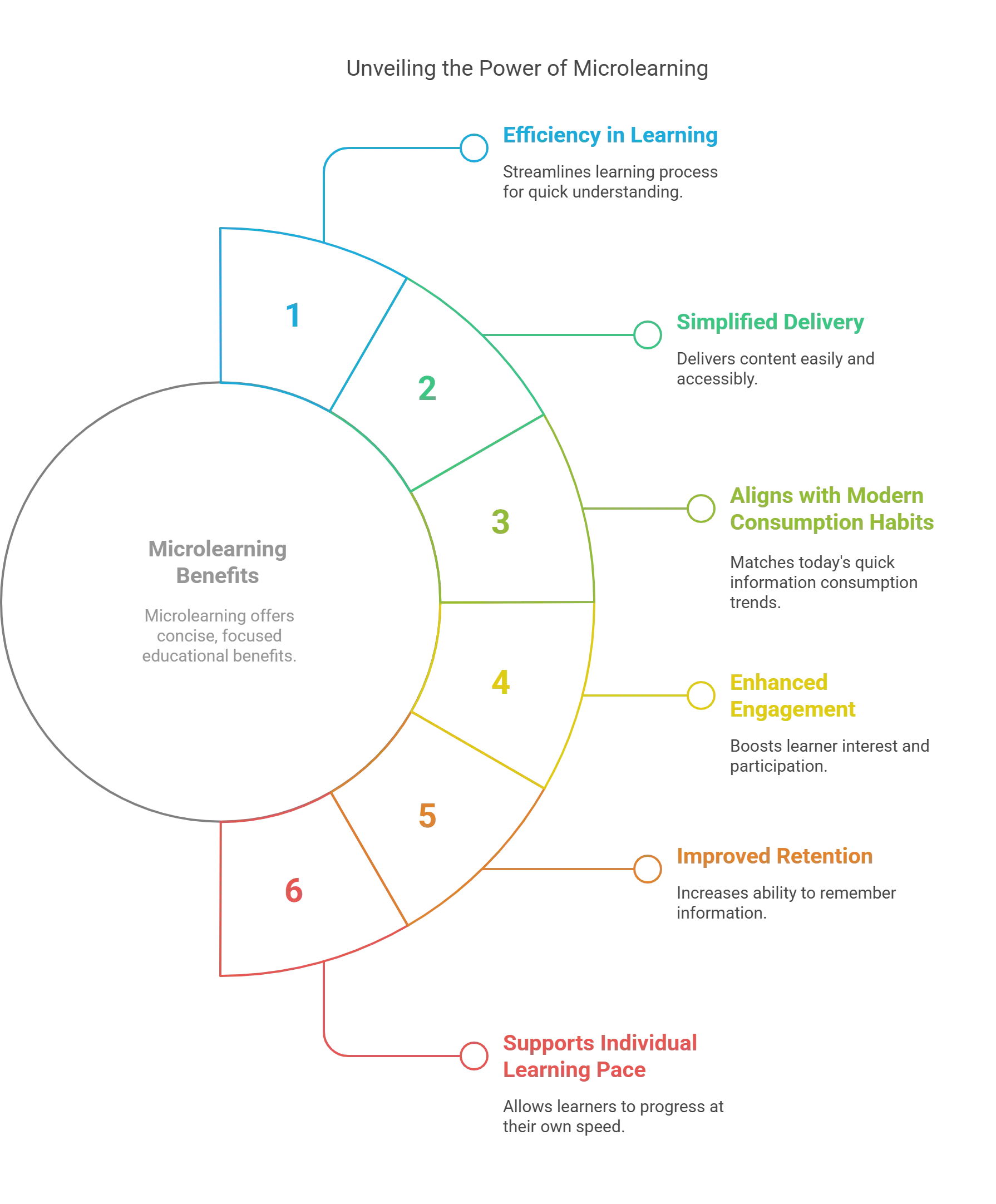
Effective Microlearning — The Secret to Engaging and Impactful Training
Effective employee training and micro-learning are key factors that set apart an average organization from a highly competitive market leader in today’s economy. Companies can deliver bite-sized, engaging content that enhances retention and efficiency by incorporating microlearning into corporate training. Organizations adopt various training, development, and learning methods to boost employee productivity and motivation, ensuring continuous growth and adaptability.
Microlearning technology as a training methodology was gaining rapid acceptance even before the pandemic, and now it is growing exponentially in the post-pandemic era.
This blog will tell you everything you need to know about the micro-learning training method, offering insights into its definition, its tangible advantages, and examples of what works and what doesn’t in your employee training strategy. So, let’s get started!
Table of Contents:
- Understanding Microlearning In-Depth
- What are the Five Popular Microlearning Methods?
- What are the Five Microlearning Best Practices for Ensuring Effective Employee Training?
- Top Six Benefits of Microlearning
- The Dos and Don’ts in Microlearning for Effective Corporate Learning
- Final Thoughts
Understanding Microlearning In-Depth
Microlearning revolutionizes the delivery and consumption of educational content by offering concise, 3-5 minute segments precisely when learners need them, with a clear and targeted learning objective. This approach enables learners to manage their learning experience, fitting it into their hectic lives at convenient times and locations.
It’s crucial to note that the effectiveness of microlearning is grounded in the scientific principles of the forgetting curve, as identified by Hermann Ebbinghaus. This curve illustrates that large volumes of information lead to a rapid decline in memory retention, with individuals forgetting about 80% of what they’ve learned within a month. This significant decrease highlights why microlearning is viewed as a hopeful strategy for creating compelling learning experiences.
By segmenting information into smaller, manageable pieces and facilitating timely review, microlearning effectively addresses the forgetting curve, improving the retention of crucial information and its application in everyday activities.

What are the Five Popular Microlearning Methods?
Microlearning examples include microcopy, microlearning videos, infographics, etc. Many microlearning techniques can be used to deliver training to employees. Some of these methods include:
1. Microcopy
Microcopies are short, highly contextual, targeted messages that help users learn. Examples include error messages, eCommerce hints, and contact form explainers.
2. Microlearning Videos
These are short, focused videos created to meet a specific training need. Micro-learning videos can be standalone videos that offer learning on particular topics or part of a longer series of videos.
Microlearning videos include explainer videos, micro-lectures, interactive videos, kinetic text-based animations, and whiteboard animations.
3. Microlearning Apps or Mobile Apps
Microlearning apps include apps like Google, YouTube, Headspace, TED, etc., that can provide micro-lessons on the go.
4. Micro-Challenges
Micro-challenges are often in games, multiple-question quizzes, polls, flashcards, and simulations and can include badges, scores, awards, or other incentives for participating.
5. Infographics
Infographics and icons are graphic representations of data and information that focus on key points and numerical values. These could be in the form of statistical infographics, timeline infographics, hierarchical infographics, list infographics, and informational infographics.
Microlearning platforms that offer diverse content types and replicate the brief, engaging experience of scrolling through social media are the most engaging to your audience. The goal is to make learning enjoyable and accessible, enabling learners to resume their progress and stay motivated quickly.

What are the Five Microlearning Best Practices for Ensuring Effective Employee Training?
Micro-learning is an effective and engaging way of delivering training modules and content to the target audience.
Here are five best practices that will help you in structuring an orderly online training program:
1. One Learning Objective Per Module
The very objective of microlearning is to deliver training in mini doses to the learners, so the focus must be on one learning objective per module.
Choose the content carefully so it addresses specific issues and equips the learner with the information necessary to tackle them. Including short quizzes at the end will help cement their learnings.
2. Bite-Size Modules
While designing training programs, one might be tempted to cram in as much information as possible. However, this might prove to be counterintuitive when it comes to microlearning.
It is recommended that the information be divided into bite-size segments. Textual content shouldn’t exceed a 5-minute read, and videos should ideally be around 10 minutes each.
Include only the content that adds value and leave out any unnecessary information.
3. Mobile Access
Microlearning training content is often accessed by employees on the go. So, it is essential that the training be mobile-ready and can be accessed on several electronic devices like smartphones, iPads, tablets, etc.
The learners should be able to access the online courses and resources whenever they want from whatever devices they are using.
4. Multi-format Content
There are many methods of delivering microlearning training, including text, video, audio, and infographics. Ideally, it is a good idea to include a multimedia format and use a variety of visuals, explainer videos, podcasts, and animations to make the training program more engaging.
Using a combination of media not only enhances your online training but also caters to people with different learning styles.
5. Customization
Microlearning courses must cater to the needs of diverse audiences. Therefore, there is no one-size-fits-all solution for designing online learning programs.
An effective microlearning training module should be able to support the individual learning needs of your employees. Customization in eLearning can be achieved with branching, a process that allows you to build differentiated learning modules.

Top Six Benefits of Microlearning
Microlearning could revolutionize your Learning & Development (L&D) strategy with its brief, impactful approach. Here’s how:
1. Efficiency in Learning
Given that employees have only 1% of their workweek available for L&D, microlearning enables quick skill acquisition or knowledge refresh, fitting seamlessly into tight schedules. This method transforms idle moments into productive learning opportunities.
2. Simplified Delivery
For employers, micro-learning streamlines the creation and distribution of training content. Leveraging intuitive tools, you can rapidly develop and absorb bite-sized courses, bypassing the need for extensive preparation associated with traditional training methods. This efficiency allows for agile responses to evolving organizational needs.
3. Aligns with Modern Consumption Habits
Reflecting on the mobile-centric world, where 58.67% of website visits in 2023 were from mobile devices, microlearning’s compatibility with mobile learning meets the modern learner’s preferences.
This ensures that training is accessible through the devices people use in daily life, enhancing engagement and effectiveness.
4. Enhanced Engagement
Microlearning captivates learners by mimicking the engaging, concise content experienced on social media.
Incorporating interactive elements like quizzes and short videos significantly outperforms traditional training formats in maintaining learner interest.
5. Improved Retention
Research indicates that microlearning can increase focus and significantly enhance long-term retention by as much as 80%. Its simplicity allows learners to easily revisit the content and refresh their knowledge and application in their roles, including improved customer interactions in client-facing positions.
6. Supports Individual Learning Pace
Unlike the one-size-fits-all approach of many traditional LMS courses, microlearning accommodates diverse learning speeds and styles, offering the flexibility to engage with content as preferred.
This adaptability boosts completion rates and positions training as an opportunity to consume knowledge rather than a disruption.
The Dos and Don’ts in Microlearning for Effective Corporate Learning
Microlearning, with its concise and targeted approach to training, offers an efficient and engaging way to enhance skill sets and knowledge. When implemented correctly, it can significantly improve knowledge retention, learner engagement, and overall efficiency.
Understanding the dos and don’ts of microlearning is crucial to leveraging its full potential. Here’s a comprehensive guide to what works and what doesn’t in microlearning.
The Dos of Microlearning
- Keep it Short and Focused: The essence of microlearning lies in its brevity. Aim for content that learners can complete in a few minutes, focusing on a single, specific objective to avoid cognitive overload.
- Incorporate Various Media Types: Use a mix of text, images, videos, and interactive elements to cater to different learning preferences and keep the content engaging.
- Make it Accessible and Mobile-Friendly: Ensure your microlearning content is easily accessible across devices, especially smartphones, to allow learning anytime, anywhere.
- Align with Learning Goals: Each micro-learning module should have a clear purpose and directly contribute to the overall learning objectives.
- Enable On-Demand Learning: Make microlearning self-contained so learners can access the information they need exactly when needed, supporting just-in-time learning.
- Apply Real-World Scenarios: Use practical examples and real-life situations to make the learning experience relevant and immediately applicable.
- Encourage Continuous Learning: Structure your microlearning strategy to promote regular engagement, reinforcing concepts over time to improve retention.
The Don’ts of Microlearning
- Don’t Overcomplicate Content: Avoid packing too much information into a single session. Microlearning thrives on simplicity and focus.
- Don’t Ignore the Learning Path: While micro learning modules are great as standalone resources, they should also fit within a broader learning pathway or curriculum.
- Don’t Neglect Assessment: Even though microlearning sessions are brief, incorporating quizzes or short assessments can help reinforce learning and gauge understanding.
- Don’t Forget Feedback: Provide immediate feedback, especially in interactive elements, to enhance the learning experience and correct misunderstandings in real-time.
- Don’t Underestimate Design: Poorly designed content can detract from the learning experience. Invest in high-quality, visually appealing materials that reflect the content’s value.
- Don’t Isolate Learners: Encourage social learning opportunities, such as discussion forums or group challenges, to complement the microlearning experience.
- Don’t Skimp on Quality: The brevity of microlearning doesn’t mean quality should suffer. High-quality content is crucial for engaging and effective learning.
By adhering to these dos and don’ts, you can create a microlearning strategy that meets your learners’ needs and maximizes the impact of your training initiatives.
When done right, microlearning can be a powerful tool in the modern educational toolkit, providing learners with the necessary knowledge and skills in a format that suits their lifestyles and preferences.
Final Thoughts
Designing microlearning programs for a generation that consumes content through mobile devices demands a unique approach to analyzing learning needs, setting objectives, and developing content than traditional desktop e-learning or classroom training methods.
The most significant advantage of microlearning programs lies in their ability to provide learners with a continuous, always-on learning experience—a journey that never needs to conclude.
At Hurix Digital, we specialize in providing top-notch learning experiences that align with these principles. We offer bespoke e-learning solutions tailored to meet our clients’ unique needs. Contact us today to discover how we can transform your learning and development strategy with effective microlearning solutions!

A highly enthusiastic and motivated sales professional with over twenty five years of experience in solution selling of training-related applications and services. Maintains an assertive and dynamic style that generates results. Ability to establish long-term relationships with clients built on trust, quality of service and strategic vision. Specializes in financial services, higher ed, publishing and government in the areas of learning and development.







